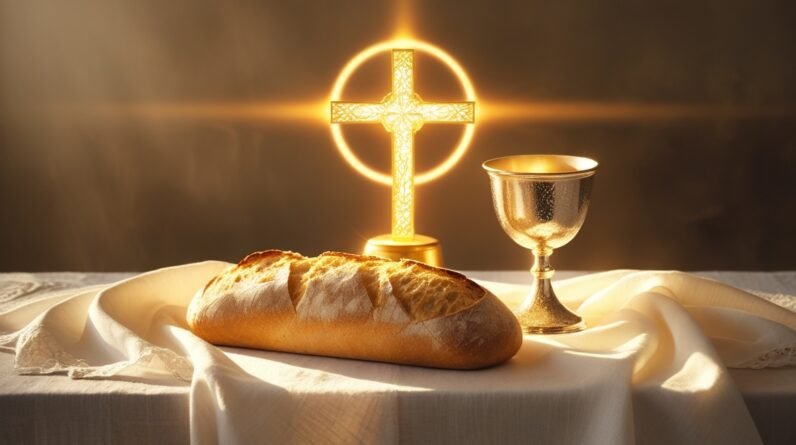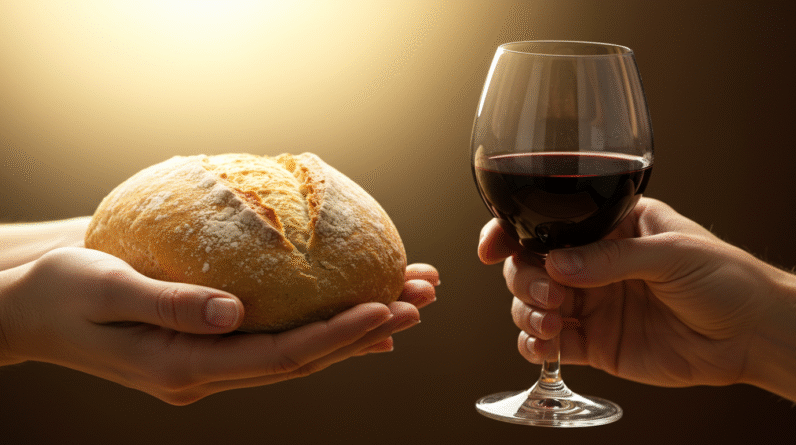Baptism and Communion: Signs of God’s Covenant
You’ve probably heard the terms baptism and communion a thousand times in church, but do you ever pause to ask what they really mean beyond the rituals? When you explore the deeper symbolism, you find that baptism and communion function as visible signs of an invisible reality: God’s covenant with His people. In this article, you’ll see how both sacraments point to God’s promises and help shape your identity as one of His people. We’ll keep the focus on “Baptism and Communion meaning” throughout, and we’ll ground each biblical reference in a reliable source so you can read the passages for yourself.
What is a covenant, and why does it matter?
A covenant in the Bible is more than a contract; it’s a pledge by God to His people that involves promises, obligations, signs, and identity. When God makes a covenant, He is binding Himself to you with promises that shape your past, present, and future. Think of covenants as relationship-making moves—God commits to you so you can live under His promises and belong to His family.
Covenants in the Old Testament had physical signs: circumcision was the sign of Abraham’s covenant (see Genesis), and the Passover meal became a sign for Israel’s deliverance from Egypt. Those signs helped people remember and live under God’s promises. You can trace forward from those Old Testament signs to the New Testament signs of baptism and communion, which carry covenantal meaning in the life of the church.
Covenants in the Old Testament
God’s early covenant signs were tangible. In Genesis, God established a covenant with Abraham and gave circumcision as the sign of that covenant, marking identity and belonging to God’s people. Later, the Passover meal acted as an ongoing reminder of God’s deliverance and faithfulness to Israel. These signs did two things: they pointed back to what God had done, and they bound a community to God’s promises moving forward.
Read the scripture and you’ll see the idea clearly: the sign creates a visible identity for the people in relation to God, and it signals ongoing reliance on God’s promises. For the New Testament community, baptism and communion inherit that function and language of covenantal sign and seal.
- See the promise to Abraham and the sign of circumcision in Genesis 17:9-14: Genesis 17:9-14.
- See the institution of the Passover as a sign of God’s deliverance in Exodus 12:14: Exodus 12:14.
Baptism: A sign of new life and belonging
When you think of baptism, think of water as a visible language God uses to tell a story about you: you die to your old way of living and are raised into new life with Christ. Baptism is not magic water; it’s a sacramental sign that conveys and seals God’s promise of new identity, forgiveness, and adoption into His family.
Baptism in the New Testament is packed with covenantal language. It’s presented as initiation into the body of Christ, into new life, and into the people of God. Whether you were baptized as an infant or later in life, the act marks you as one who belongs to God’s covenant people. This is central to the “Baptism and Communion meaning”: both sacraments mark your inclusion in God’s covenantal community.
Biblical foundations for baptism
Several New Testament passages make the meaning of baptism especially clear. Jesus’ Great Commission links baptism to discipleship and inclusion in the triune name of God. Paul describes baptism as participation in Christ’s death and resurrection. Acts shows baptism as the response and sign of God’s saving work in converting hearts. These texts together anchor baptism as a covenant sign.
- Jesus commands baptism as part of making disciples in Matthew 28:19-20: Matthew 28:19-20.
- Paul explains the symbolic participation in Christ’s death and resurrection in Romans 6:3-4: Romans 6:3-4.
- Paul further ties circumcision imagery and baptism together in Colossians 2:11-12: Colossians 2:11-12.
- In Acts, baptism follows repentance and the gift of the Spirit, showing its covenantal place in conversion (e.g., Acts 2:38): Acts 2:38.
What baptism communicates about God’s promises
Baptism announces that God’s promises are now effective in your life: forgiveness, cleansing, adoption, and the promise of resurrection life. When the early church baptized, it was declaring that God’s covenantal rescue—first announced in Israel—has now come to fulfillment in Jesus, and you are included.
Through baptism, you publicly affirm the covenant promises: God forgives, God adopts, God gives the Spirit, and God promises a future resurrection. If you’re wondering about the “Baptism and Communion meaning,” baptism is the doorway into that covenantal reality.
Infant baptism vs believer’s baptism
Church traditions differ on whether baptism should be for infants or for confessing believers. If you were raised in a tradition that baptizes infants, the practice reflects confidence that God’s covenant promises extend to families and to the children of believers—analogous to circumcision in the Old Testament. If you come from a tradition that emphasizes believer’s baptism, the focus is on conscious repentance and profession of faith before baptism.
Either way, the underlying “Baptism and Communion meaning” remains: baptism is about identity and covenantal belonging. The difference is whether the sign is applied before you can speak for yourself (infant baptism) or after you consciously respond (believer’s baptism). Both readings point to God’s initiative and human response.
Communion (The Lord’s Supper): A sign of remembrance and promise
Communion, also called the Lord’s Supper or Eucharist, is the meal Jesus instituted with his disciples and commanded the church to continue. It’s rich in covenantal meaning—an eating and drinking that recalls God’s saving acts, seals the promise of forgiveness, and anticipates the final fulfillment of the covenant in the kingdom to come.
Communion works like a covenant meal. In the Old Testament, covenants were often sealed at meals. Jesus’ meal at the Last Supper takes up that language and recasts it: the bread and cup point forward to the new covenant in His blood, which secures forgiveness and promises a future feast with God’s people. So when you take communion, you’re participating in a sign that both remembers and makes present God’s covenant promises.
Biblical foundations for communion
Jesus’ words at the Last Supper set the meaning of the meal: the bread and cup signify his body and blood and proclaim the new covenant. Paul recounts the tradition and warns the Corinthians to take the Lord’s Supper worthily, implying the meal’s deep spiritual import.
- See Jesus’ institution of the Lord’s Supper in Luke 22:19-20: Luke 22:19-20.
- Paul recounts the tradition and commands remembrance in 1 Corinthians 11:23-26: 1 Corinthians 11:23-26.
What communion communicates about God’s promises
When you receive communion, the bread and cup communicate several key covenantal truths. First, they commemorate Christ’s sacrificial death—the means by which the new covenant is established. Second, they offer a promise: forgiveness and reconciliation are available through Christ’s body and blood. Third, they anticipate the eschatological fulfillment—Jesus’ statement that he will not drink the fruit of the vine again until the kingdom comes points to a future wedding feast.
Communion ties you into God’s story of redemption and points your hope forward. This is central to the “Baptism and Communion meaning”: both sacraments recall and renew the covenantal promises.

How both sacraments point to God’s promises
Both baptism and communion are signs and seals. They make a visible mark of an invisible reality—God’s promises. Baptism visibly declares that God has created a new reality for you in Christ: you’re forgiven, you’re adopted, and you’re joined to the body of Christ. Communion repeatedly reminds you that Christ’s sacrificial death and the promise of the new covenant are the foundation of these blessings.
You can think of baptism as the sign of your entry and identity, and communion as the ongoing sign that nourishes and renews that covenant relationship. Together they form a rhythm: you enter by baptism and you keep remembering and participating through communion. That rhythm underlines the “Baptism and Communion meaning” as covenantal and communal.
Baptism seals identity; communion sustains life
Baptism marks you. It’s an initiation rite. When you are baptized, you are marked as God’s own. Communion sustains you. Each time you participate, you are reminded of God’s promises and you renew your dependence on Christ’s sacrifice.
This dynamic is evident in Scripture and in the life of the church. Baptism’s imagery of burial and resurrection points to the once-for-all change in your status before God. Communion’s repeated nature fosters ongoing remembrance and hope until the day when the kingdom is fully realized.
Your identity as God’s people through these signs
When you internalize the “Baptism and Communion meaning,” you’ll see how these sacraments shape your sense of who you are. You are not simply a private believer; baptism places you within a covenant community—the body of Christ. Communion renews your connection to that body and to the covenant promises that bind you together.
Belonging isn’t abstract; it’s formed by signs, words, and practices. Baptism is your membership marker and the community’s recognition of you as part of God’s people. Communion is the communal meal that expresses and renews the bonds of that membership. When you take both seriously, your faith life becomes less about isolated belief and more about being formed by covenantal practices.
Community, accountability, and identity
These sacraments encourage you to live in accountable fellowship. Baptism invites the community to welcome and nurture, while communion invites the community to examine, remember, and renew. Paul’s instruction to examine oneself before taking the Lord’s Supper emphasizes that the meal is not a private act but a public, covenantal one.
You are shaped into a people who remember God’s acts, who live under God’s promises, and who bear witness to those promises in the world. That communal identity is the practical outworking of the “Baptism and Communion meaning.”
Differences in practice among Christian traditions
You’ll notice Christians do baptism and communion differently. Some churches baptize infants; others require a personal profession of faith. Some churches understand the Lord’s Supper as a literal real presence; others see it as a memorial. These differences matter, but they don’t erase the central covenantal thrust: both sacraments remain signs of God’s promises and identity.
Your tradition’s emphasis will shape the way you understand covenantal language. For example, traditions that baptize infants often draw an explicit parallel to Old Testament covenant signs, arguing that children of the covenant should be included. Traditions that practice believer’s baptism emphasize conscious repentance and personal profession. Likewise, Eucharistic theology ranges from a sacramental presence that communicates grace to a symbolic remembrance. Knowing your tradition’s theology will help you appreciate how the “Baptism and Communion meaning” is expressed in worship and life.
How to talk about differences humbly
When you encounter different practices, try to listen and ask questions. You’ll find that many differences come from different emphases rather than outright contradictions. The shared recognition that these are covenant signs provides common ground. So whether you’re at a pulpit or a kitchen table, you can explain that both baptism and communion communicate God’s promises and form God’s people, even if you disagree on the mechanics.
Practical implications for your daily life
If baptism and communion are signs of God’s covenant, then they shape how you live. Baptism gives you a new identity to live out: you are a forgiven, adopted child of God. Communion invites continual repentance, gratitude, and hope. The two together shape a rhythm of initiation and nourishment that anchors your spiritual life.
Practically, baptism calls you to live out the death-to-life reality in everyday choices—putting off old patterns, embracing justice and mercy, and embodying the new creation. Communion calls you to a posture of remembrance and dependence: you repeatedly recall your need for Christ and the communal nature of salvation.
How to participate meaningfully
Participate in baptism and communion with intention. If you are being baptized, make sure you understand the covenantal promises being affirmed. If you regularly take communion, use it as a moment to remember, repent, and renew. Many traditions offer simple practices: confession before the meal, reading the Scriptures that institute the supper, or pausing to thank God for the promises sealed in the meal.
When you treat these sacraments as formative, they’ll shape how you think, speak, and act—not because the ritual has secret magic, but because God uses embodied practices to form your faith.
Frequently asked questions about baptism and communion
You probably have questions: Does baptism save? Do you have to be baptized to be saved? Is communion only for church members? How literal is the language of body and blood? These are real questions with real pastoral consequences, and they deserve careful answers.
The Bible connects baptism with salvation language in some places, but it also emphasizes faith, repentance, and the work of the Spirit. For example, Peter links baptism to the promise of salvation in 1 Peter 3:21, but the broader New Testament context stresses that faith in Christ undergirds the covenantal sign. Communion is presented as a communal, covenantal meal; Paul warns that taking it irreverently is spiritually dangerous. These texts indicate that sacraments are not mere symbols or empty rites—they carry real spiritual gravity.
- See the connection between baptism and salvation language in 1 Peter 3:21: 1 Peter 3:21.
- See Paul’s warning about partaking in an unworthy manner in 1 Corinthians 11:27-29: 1 Corinthians 11:27-29.
Addressing common objections
If you worry that sacraments are mere superstition, remember that the New Testament frames them as God’s means for forming covenant identity. If you worry that they’re too ritualistic and exclude those who doubt, remember communities often invite believers into these practices as opportunities to grow. Whatever you believe about the mechanics, you can’t ignore how baptism and communion function to form Christian identity and faithfulness.
How to prepare for baptism and communion
Preparation matters. If you’re planning to be baptized, talk with your pastor about what the church believes and expects. Learn the scriptural basis, make a public profession of faith when appropriate, and ask for the community’s support. If you’re preparing to take communion, take time for confession, remembrance, and gratitude. Many churches provide brief liturgies or questions to help you prepare spiritually.
Preparation isn’t about earning worthiness; it’s about recognizing the covenantal seriousness of the signs. The sacraments are meant to shape you, so enter them with reverence, humility, and joy.
Sample steps to prepare
- Reflect on your need for grace and the promises that baptism and communion seal.
- Read the key texts: Matthew 28:19-20 for baptism, Luke 22:19-20 and 1 Corinthians 11:23-26 for communion.
- Talk to your church leaders to understand how your tradition frames the rites.
- Practice confession and gratitude before communion, and seek mentoring or discipleship before baptism.
The goal is that these signs should shape your life, not just be rituals you go through.
The eschatological promise in both sacraments
Both baptism and communion point forward—to the final fulfillment of God’s covenant in the new creation. Baptism anticipates the resurrection life that will be fully realized, and communion anticipates the heavenly banquet when all things are made new. When you participate, you align yourself with God’s future promise.
Jesus’ words at the Last Supper about not drinking the fruit of the vine until the kingdom comes make that future hope explicit. Baptism’s resurrection imagery reminds you that what God promises now will be consummated in the resurrection.
- See Jesus’ forward-looking statement about the kingdom in Luke 22:18: Luke 22:18.
Living in the “already and not yet”
You live in an “already and not yet” tension. The covenant promises are already enacted in Christ, yet their fullness awaits the future. Baptism and communion help you hold that tension—they show you who you are now and what you long for. As you partake, you’re reminded that God’s covenantal promises are both present realities and future hopes.
Bringing it home: What “Baptism and Communion meaning” means for you
If you leave this article with one takeaway, let it be this: baptism and communion are not mere ceremonies—they’re covenant signs that shape your identity, faith, and community life. Baptism marks your entrance into God’s covenant family; communion invites you to remember and participate in the covenant meal that sustains that family until Christ returns.
You’re invited into a story bigger than yourself. These rites anchor you in God’s promises and orient your life toward the future God has promised. When you live out the implications—pursuing justice, showing mercy, loving your neighbor—you embody what the sacraments proclaim.
Practical next steps
Consider these simple steps:
- If you’re unbaptized and curious, speak with a pastor in your community about baptism and the promises it signifies.
- If you take communion, prepare spiritually by reflecting on Scripture and confessing sin.
- Join a small group or discipleship community to live out the covenantal implications of being God’s people.
These practices aren’t ends in themselves; they empower you to live as a covenant people.
Conclusion
Baptism and communion are more than rituals; they are the church’s covenantal language. They show you God’s promises, mark your identity as His people, and sustain your life in the Spirit as you wait for the kingdom to come. When you think about “Baptism and Communion meaning,” think covenant: God initiates, God promises, and God sustains through visible signs that shape your life.
Explore More
For further reading and encouragement, check out these posts:
👉 7 Bible Verses About Faith in Hard Times
👉 Job’s Faith: What We Can Learn From His Trials
👉 How To Trust God When Everything Falls Apart
👉 Why God Allows Suffering – A Biblical Perspective
👉 Faith Over Fear: How To Stand Strong In Uncertain Seasons
👉 How To Encourage Someone Struggling With Their Faith
👉 5 Prayers for Strength When You’re Feeling Weak

📘 Jesus and the Woman Caught in Adultery – Grace and Mercy Over Judgement
A powerful retelling of John 8:1-11. This book brings to life the depth of forgiveness, mercy, and God’s unwavering love.
👉 Check it now on Amazon
🌍 “Every great message deserves a home online.”
Don’t let your calling stay hidden. Start a Christian Blog/Website using Hostinger — with 99.9% uptime, free domain, and SSL, your voice can shine for God’s glory anytime, anywhere.
👉 Begin today. Try it RISK-FREE!
“Your body is God’s temple — care for it with purpose.”
Renew your energy and restore balance the natural way. Mitolyn helps support a healthy metabolism, giving you the vitality to live out God’s calling with strength and confidence.
🌿 Unlock Your Metabolic Power. Burn More Calories & Feel Great With Mitolyn.
👉 Start Today. Check Price Now.
As a ClickBank & Amazon Affiliate, I earn from qualifying purchases.
Acknowledgment: All Bible verses referenced in this article were accessed via Bible Gateway (or Bible Hub).
“Want to explore more? Check out our latest post on Why Jesus? and discover the life-changing truth of the Gospel!”






